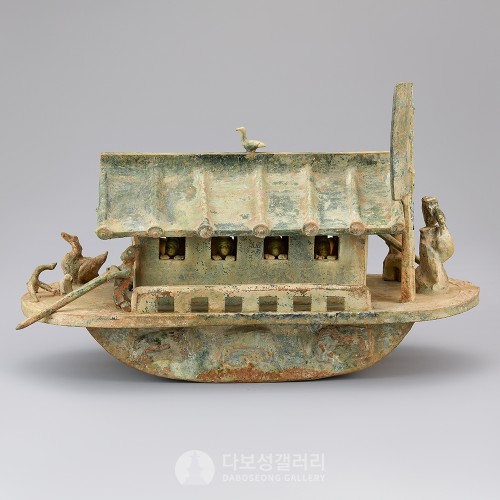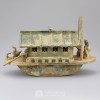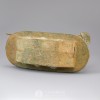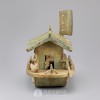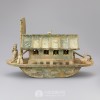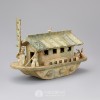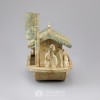작품 정보
한나라 도자와 부장품
한나라 시대에는 사회가 안정되고, 농업과 수공업이 빠르게 발전했으며, 후하게 매장하는 풍습이 민간에서 널리 성행했습니다. 이에 따라 도기 제조업도 활발해져, 대량의 명기(明器)가 제작되어 부장품으로 사용되었으며, 부장품들은 대부분 정교하고 풍부한 구성을 갖추고 있었습니다. 부장품은 죽은 자가 저승에서 사용할 용구라는 점에서 제기(祭器)와 구별됩니다.
부장품 중 소량으로 제작된 석제·금속제·목질칠기 제품을 제외한 대부분은 도기로 만들어졌습니다. 이는 도기가 천 년이 지나도 부패하지 않기 때문입니다. 도기는 단순히 음식 용기로 사용된 것이 아니라, 다락집·창고·부뚜막·수레·배·말·노예 등 다양한 생활 모습을 본뜬 가상의 환경을 조성하는 데 활용되었습니다.
명기 중 대야·항아리·주전자·존(樽, 술통) 같은 기명(器皿)에는 분채(粉彩, 가루 형태의 채색 안료)를 입혔는데, 이는 태토(胎土)와 쉽게 섞이지 않아 조금만 만져도 벗겨질 정도였습니다. 또한, 작은 생활 모형에는 녹유(綠釉)라 불리는 녹색 저온 유약을 입혔는데, 이 유약은 독성이 있어 실제 생활용품에는 사용되지 않았습니다.
한나라 도기 중에서도 와당(瓦當)의 예술적 성취는 특히 두드러졌습니다. 한나라 시대 도자기는 조형이 중후하고 풍만하며, 많은 기형(器形)이 동기(銅器, 청동기)의 형식을 모방했습니다. 도기 표면에는 유약을 칠한 뒤 약 950~1000℃의 온도로 구웠으며, 이로 인해 오늘날 발견되는 도기의 기면(器面)에는 미세한 잔무늬가 남아 있습니다.
한나라에 이르러 우리나라 북방에서 사용된 만두요(馒头窑, 둥근 형태의 가마)는 비교적 완성된 형태를 갖추었으며, 남쪽에서는 용요(龍窯, 용 모양의 긴 가마)가 등장하면서 가마의 규모가 커지고 소성 시간도 단축되었습니다.
한나라 전기의 도기는 진나라 도기와 특징이 비슷하며, 비교적 크고 소박하면서도 생동감이 넘칩니다. 산시(陝西) 함양(咸陽)과 장쑤(江蘇) 서주(徐州)에서 출토된 서한(西漢) 병마용(兵馬俑)의 조형과 진용(秦俑)은 당시의 예술적 풍격을 보여줍니다. 서한(西漢)은 문경지치(文景之治)를 거쳐 한무제(漢武帝) 시기에 절정에 이르렀으며, 이 시기 인문 예술, 자연 과학, 수공업, 제지업, 상업 등이 모두 번영했습니다.
한나라 녹유 도선
바다에 떠있는 배 모양의 녹유도선입니다. 녹유(綠釉)는 도기의 표면에 납유를 바른 뒤 불에 구워낸 것을 말합니다.
배 위에 세워진 기와집 지붕에는 새가 앉아 있고 벽에 뚫린 창문 안에 사람들이 밖을 내다보고 있습니다.
선두에는 선장이 서 있고 선미에는 배를 정박시킬 때 사용하는 닻과 바람을 이용해 배를 움직이는 돛, 하늘의 신과 지상세계를 연결하는 메신저인 새가 있습니다.
이와 같은 형태의 도기(陶器)는 사회가 안정되고 농업과 수공업이 발전한 한나라 때 매장 문화가 성행하면서 만들어지기 시작하였습니다.
특히 녹유 도기는 황실에서만 사용하던 것으로 일반 백성들은 녹유를 사용할 수 없었기 때문에, 이러한 유물은 황실에서 부장품으로 사용하기 위해 제작되었을 것으로 예상됩니다. 중국에서 한나라 시기부터 생산된 녹유 도기는 해외 무역 과정에서 수출되어 주변 나라 지배층의 부장품으로도 사용되었습니다.
중국에서 생산된 녹유 전돌이나 기와가 우리나라에도 수입되어 신라 경순왕릉이나 백제 미륵사지 등 삼국시대 각종 왕릉 및 사찰 유적에서도 출토된 바 있습니다.
━━━━━
汉代的随葬品
汉代,由于社会稳定,农业、手工业发展较快,厚葬风气在民间普遍盛行,制陶业大量烧制陶明器用来随葬,大部分随葬品丰富而精细。它与祭器之别在于它是专门供死者在阴间所用而非为生者用具。
陪葬品中除少量石质品、金属制品、木质漆器以外,被大量使用的为陶制品,因为这种材质可历千年而不腐败。除饮食所用的器皿外,大量模拟生活场景,如陶制的楼阁、仓房、灶台、车马、船只、奴仆等等,营造虚幻环境供死者享用。
明器当中的盆、罐、壶、尊之类的器皿,一般都在素坯之外敷设一层粉彩,并不与胎体相融,稍摩擦便脱落;小型生活场景的模型,外表都施加绿色低温铅釉,称为绿釉,当时人们知晓这种铅釉有毒性,所以在日常生活用品中并不使用。
在汉代陶器当中,瓦当的艺术成就也非常突出。汉代的陶瓷器,造型浑厚而饱满,许多器形模仿铜器造型。器物表面施釉烧成温度约在950度到1000度之间,为低温釉,所以今天所见到的汉器表面出现有细微碎纹。
到汉代为止,我国北方使用的馒头窑已基本达到比较完善的地步。在南方,此时已出现比较成熟的龙窑,增大窑室的同时也缩短了烧成时间。
汉代前期的陶塑制品与秦代陶塑风格相近,型体较大,形象生动质朴,栩栩如生。在陕西咸阳、江苏徐州发现的西汉时期兵马俑,其造型、阵容展现出当时的艺术风格。西汉在经过“文景之治”后,在汉武帝时期达到了鼎盛时期。其人文艺术、自然科学、手工业、造纸业、商业、水利等都达到了一个繁荣的时期。
汉代的绿釉陶船
这是漂浮在海上的绿釉船。绿釉是指在陶器的表面涂上铅釉后用火烧制的器皿。
船上置瓦房,瓦房屋顶上贴着一只鸟,窗户内的人们正向外张望。
船头有位船长,船尾摆放着停泊时使用的锚、利用风使船移动的帆、连接天神和地面世界的报信鸟。
像这样的陶器是在社会稳定、农业和手工业发达的汉代埋葬文化的盛行而开始制作的。
尤其是除了皇室以外,普通民众不能使用绿釉陶器,因此推测该灯盏是皇室的随葬品,中国汉代开始生产的绿釉陶,在国外贸易过程中出口,也作为周边国家统治阶层的随葬品。
在韩国三国时代新罗敬顺王陵或百济弥勒寺址等各种王陵及寺庙遗址也曾出土过于中国引进生产的绿釉砖或绿釉瓦。
━━━━━
Pottery and Burial Objects in the Han Dynasty
During the Han Dynasty, society was stable, and agriculture and handicrafts developed rapidly. The custom of lavish burials was widely practiced among the people, leading to the mass production of mingqi (明器), or burial objects, in the pottery industry. Most burial goods were crafted with great precision and variety. Unlike ritual vessels (jigi, 祭器), burial objects were meant for use in the afterlife.
Apart from a small number of burial goods made of stone, metal, or lacquered wood, the majority were made of pottery, as ceramics do not decay even after thousands of years. These burial objects were not limited to food containers; they also included miniature representations of houses, granaries, stoves, carts, boats, horses, and even slaves, creating an idealized version of daily life for the deceased in the afterlife.
Among the mingqi, vessels such as basins, jars, kettles, and wine containers (zun, 樽) were coated with powder pigments (fenchai, 粉彩). These pigments did not blend well with the clay body and could be easily rubbed off with minimal contact. Additionally, small figurines and household models were coated with green glaze (lüyou, 綠釉), a low-temperature glaze known to be toxic, which is why it was not used for everyday wares.
Among Han Dynasty ceramics, roof tiles and end tiles (wadang, 瓦當) were particularly noteworthy for their artistic achievements. Han pottery was characterized by its robust and full-bodied forms, with many designs imitating the shapes of bronze vessels (dongqi, 銅器). The surfaces of these pottery pieces were glazed and fired at temperatures between 950–1000°C, resulting in the fine, crackled patterns visible on their surfaces today.
By the Han period, the mantou kiln (馒头窑, "steamed bun kiln") used in northern China had reached an advanced stage of development. In the south, the dragon kiln (longyao, 龍窯) had also emerged, allowing for an increase in kiln capacity and a reduction in firing time.
Early Han ceramics shared many characteristics with those of the Qin Dynasty. They were relatively large, simple in form, yet lively in expression. The Western Han Dynasty terracotta army (bingmayong, 兵馬俑) excavated in Xianyang, Shaanxi Province, and Xuzhou, Jiangsu Province, reflects the artistic style of the time. The Western Han Dynasty flourished, reaching its peak under Emperor Wu (Han Wudi, 漢武帝), during which literature, arts, natural sciences, handicrafts, papermaking, and commerce all prospered.
A Green-Glazed Earthenware Model of Boat, Han Dynasty
This green-glazed earthenware boat figurine looks like sailing in the ocean. Green-glazed potteries are fired after being glazed with lead.
Birds are sitting in the middle of the tiled roof, and figures are watching outside the window pierced into the wall.
The captain stands at the front, and at the back are an anchor, sail, and a bird, a messenger connecting the god and the ground.
This kind of earthenwares has been produced since the Han Dynasty when Han, the country of agriculture and handcraft, was widespread with burial culture.
Green-glazed potteries, in particular, were used only in the imperial court, implying that they were produced to use as grave goods. Green-glazed potteries since the Han Dynasty are presumed to be exported to neighboring countries and used as grave goods.
Green-glazed bricks or roof tiles produced in China have been imported to Korea, and some of them were excavated from several royal graves or historic temple sites, such as the tomb of King Gyeongsun and the Mireuksa Temple Site.
CONDITION
NOTICE
상담/문의 : 02- 730-5601 / 02- 730-7566
